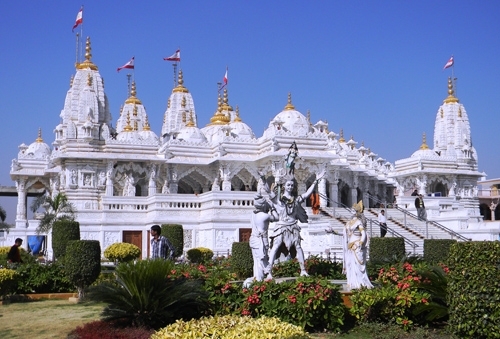Day 1: Pick up at Gandhidham/Bhuj Railway station. After freshen up proceed to Black Hill & white Desert. Dinner & Night Stay at Rann of Kutch in Bhunga at Hodka Village or Bhuj.
Product Description
Black Hill : Kala Dungar (Black hill) is the home to the Duttatreya temple. It overlooks the spectacular Rann of Kutch where one can spot white foxes. These foxes respond to the call of beats of a steel plate and shouts of ‘langa’ and come and eat the food/Prasad of rice laid down for them by the priest.
Day 2: After breakfast proceed for local sight -seeing at Mandvi. Night Stay at Bhuj.
Places to visit at Mandvi :
Wind Farm : Wind Farm or mills is the very beautiful place of Mandvi. It is the heaven on the earth. One who is visiting must visit the Wind Farm-Pavanchakki
Ship building: On the banks of the Rukmavati River, just south of the bridge, you can visit the still-active shipbuilding yard. Craftsmen still assemble ships out of wood, for local or international clients, and you can feel free to watch them work.
Vijay Vilas Palace: Built in 1929 by Rao Vijayrajji, this palace is very well-maintained, and often the scene of filming for Bollywood productions. It was built of red sandstone in the Rajput style, with a main central dome, Bengal domes at the sides, bastions at the corner, and colored glass windows. The balcony at the top affords a superb view of the surrounding area, and the king’s tomb can also be seen.
Day 3: After Breakfast proceed to Mata Nu Madh, Lakhpat, koteshwar, Narayan Sarovar. Night Stay at Bhuj.
Narayan Sarovar: One of the 5 Holy Sarovar prescribed in the Puranes as a place of pilgrimage for the Hindu situated on the mouth of Sindhu river & Arabian sea. Have a big temple of Adinarayan situated about 150 kms from Bhuj.
Lakpat : The Lakhpat fort rises like a phoenix from the earth. Its walls stretch across the arid canvas. The fort looks grand despite the dilapidation.
Lakhpat is an 18th century fort and it was a famous port until it became redundant due to the 1819 earthquake. When Guru Nanak Ji visited he stayed in one of the houses in the settlement inside the fort on his way to Mecca. The house was later turned into a Gurudwara which is visited by many sikh devotees even today
Day 4: After breakfast proceed for Tera , Pingleshwar Beach Ram wada & Jakho. Night at Bhuj.
Tera : A heritage Village located in the remote Abadasa Taluka of Kutch with a history of over 500years old.
The unique feature of tera is three manmade lakes. They interlink is a fascinating work of engineering and water management.
Jain pilgrims at Tera : Shamlaji Parshwanath ji The temple is remarkable one for its sculptures & the glass paintings.
Day 5 : After breakfast proceed to Dholavira. Night stay at Dholaveera.
Dholavira is the larger of the two most remarkable excavations of the Indus Valley Civilization or Harappan culture, dating back to 4500 years ago. While the other site, Lothal, is more exhaustively educated and easier to reach, a visit to Lothal only complements, rather than replaces, a visit to Dholavira. What this site offers you, in the intense environment that comes with being surrounded by the Great Rann of Kutch, is a unique insight into the pioneering Harappan mind, with one of the world’s earliest and best planned water conservation systems and what might be the world’s first signboards, written in ancient Indus script.
The excavation also tells the story of the 7 stages of the civilization, from development to maturity to decay, the last of which hints at a strange piece of history, with more questions than answers. After the peak of the civilization Dholavira was temporarily abandoned, after which it seems that the settlers returned with a markedly de-urbanized culture. There are hints that they willingly chose to simplify their lives, rather than try to ride the collapse of their once glorified civilization. Here, on the ruins, you will have a chance to contemplate what progress and civilization mean and what, if anything, is truly permanent.
Day 6 : After breakfast proceed for local sightseeing at Bhuj.And depart from Kutch with wonderful memories.
Places to visit in Bhuj
Prag Mahal: Rao Paragmalji’s Palace is an ornate Italian marble and sandstone building which was constructed in the latter part of the 19th century. Parts of it are now used for government offices but the vast Darbar Hall and the Clock Tower are open to the public.
The Kutch Museum : The Kutch Museum was earlier known as Fergusson Museum. It was built by Maharao Khengarji III in 1877 AD. The museum is constructed in Italian style and located on the banks of the Hamirsar Lake. It is one of the famous museums in the entire state and has a rich collection of Kshatrapa inscriptions, various archeological objects, fine collection of arms and specimens of various crafts of the Kutch region.
Swami Narayan Madir : Visit first time in Kutch in 1860. He spends nearly 30years in Gujrat and visitedkutch nearly 20 times with his blessing first temple built in1890 near Darbar Gath.
New temple near Hameshar Talao started to built in 2003 & tekan 7yrs to built. Fourty thousand sq. ft.temple have 250 pillars 250ft length &160 ft width with magnificent idol of Radha Krishna.
| See also different: | |



